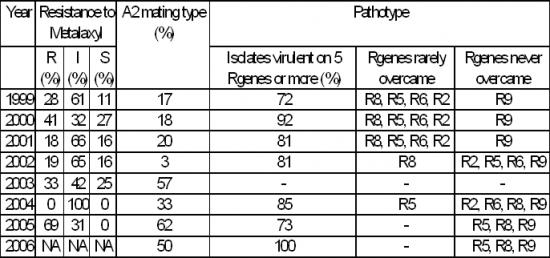Context
Late blight, caused by Phytophthora infestans (Mount.) de Bary, is regarded as being the potato disease causing the most damage. Warning systems based on biological observations and epidemiologic models utilizing climatic data provided by automatic weather stations make it possible to schedule the treatments in order to improve the effectiveness of the protection while avoiding useless spraying. The model used (Guntz-Divoux) was developed in the sixties for the protection of susceptible cultivar of Bintje type and did not envisage adaptation for more resistant cultivar. In addition, new populations of late blight appeared in Europe since the eighties due to massive importation of consumption potatoes from Mexico, centre of origin of Phytopthora infestans. Many studies tend to show that these populations replaced the old ones. This phenomenon would be explained by a greater fitness and a higher aggressiveness of the allien populations. It would also be explained by the important increase in genetic diversity due to the sexual reproduction occurring following the introduction of A2 mating type inexistent before.Objectives
The general objective of this project is to adapt the late blight warning system based on the climatic model Guntz-Divoux (GD). In particular, it aims :
- to evaluate the occurrence of the new populations on our territory on the basis of phenotypic criterion;
- to check the validity of the weather criteria currently used in relation to the pathogenetic behaviour of a sample of collected isolates;
- to define the parameters allowing to quantify and to take into account cultivar resistance.
Results obtained
Isolates were sampled since 1999 in various situations (garden, farming systems, volunteers and waste dump, etc). Their characterization (see table 1) showed that strains of A2 mating type are well represented in our areas. The high proportion of strains resistant to metalaxyl as well as the complexity and the diversity of the profiles of virulence are indicators support (1) the replacement of the old populations by new ones and (2) the existence of an important genetic re-combinations by effective achievement of sexual reproduction. [image] Analysis of aggressiveness components on a sample of isolates revealed the presence of a high proportion of strains with a very short incubation period : some strains are able to finish their incubation in 2,5 days whereas, under the same conditions, the prediction of the model was of 3,5 days. Such observations tend to confirm the assumption of an pathogenicity increased within the new populations. Kinetics of foliage destruction by late blight were characterized, in field, on a set of common cultivars compared with reference cultivars of various susceptibilities, and that, during several years and in several localities. Two criteria of cultivar susceptibility classification were analyzed in order to highlight the respective importance of partial and total resistance. These criteria are : - the slope of the regression line calculated on the linearized disease progression curve (r), - the time necessary for the destruction of 50 % of the foliage (TL50). Parameter 'r' represents the importance of partial resistance while TL50 reflects, partly, the delay of the installation of the infection related to the later occurrence of virulent strains. The levels of resistances are then evaluated by comparing the values obtained on the cultivars tested with those of references. This system, to be improved, leads to the following conclusions : - some cultivars have a stable behaviour: Innovator is characterized by a delay of the infections followed by a fast destruction of the foliage, whatever the year or the locality, - others cultivars show important behaviour changes between years and localities : Eden and Gasore, completely resistant in 2001, were completely destroyed in 2004. - partial resistances, characterizing certain cultivars, are not well highlighted by the criterion 'r' whereas the TL50, calculated on the first phase of the epidemic development, makes it possible to better distinguish them. TL50 does not have a univocal significance: it indicates a delay of the first infection but also a slower evolution of the disease in its initial phase. In these experimental conditions, the interactions between plots are important, due to the high level of inoculum coming from more susceptible cultivars. For this reason, effects of partial resistance cannot be highlighted any more by the parameter 'r' calculated over all the period of destruction of the foliage.Contribution
Biometry, Data processing and Agro-meteorology Section : statistical assistance.
Farming Systems Section : project management, organisation and follow up of laboratory and field experiments.
Partners
Asbl. Pameseb
Asbl. CARAH
CRAW off coordinator
Camille Bédard
CRA-W - Section Systèmes agricoles
Rue de Serpont, 100
B-6800 Libramont
Tel : +32 61 23 10 10
Fax : +32 61 23 10 28
Email : c.bedard@cra.wallonie.be
Funding
- CRA-W - Walloon Agricultural Research Centre
